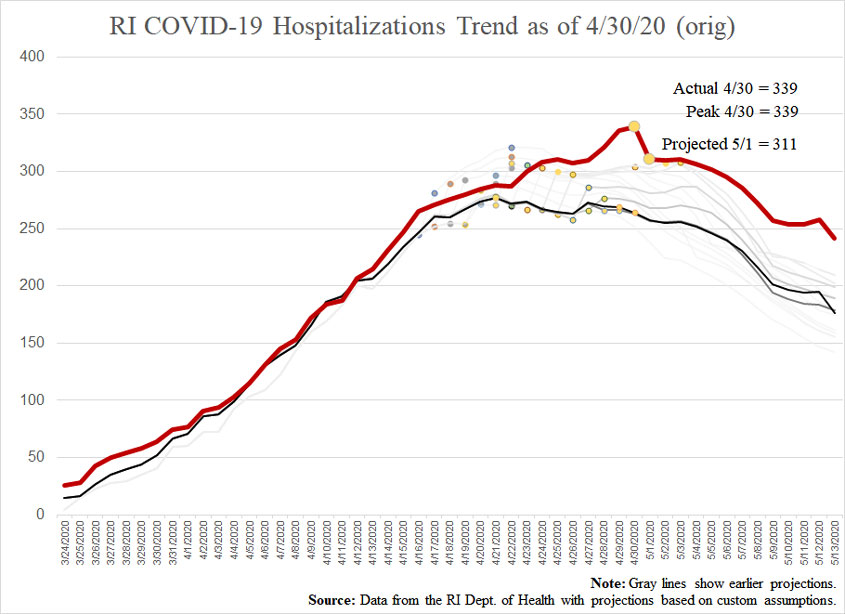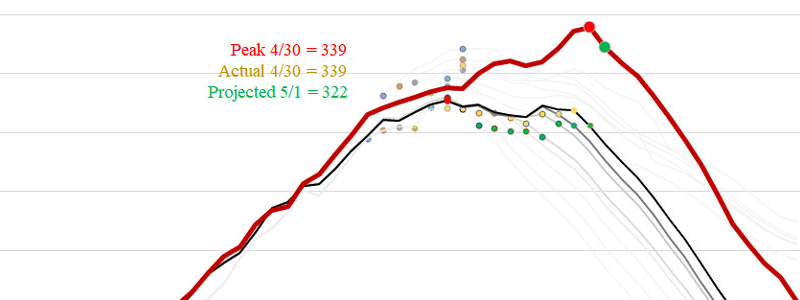Games with Models, All Out of Trust Edition, 4/30/20 Data
Remember when the governor’s office and reporters were saying that the number of COVID-19 hospitalizations was the statistic to watch because we know how many people are in the hospital, but can’t know how many people have the disease but haven’t been tested? Well, that was before the numbers started going down. At that point, hospitalizations stopped mattering as much.
Now, out of nowhere, the state has changed its method of counting hospitalizations, and revised its estimate up by about 25%. You might think that such a large change would be done with the utmost concern for the public trust. If so, you would be wrong. Here’s the timeline:
- Yesterday afternoon, the governor dropped the bomb that Rhode Island’s tourist season is essentially cancelled this year.
- This morning, the daily data release did not arrive at the usual time in the late morning.
- At 1:00 p.m., the governor replaced her usual statement and press conference with a photo-op video for children.
- Shortly after that event ended, the state Department of Health finally updated its numbers, showing a big upward revision in hospitalizations.
This is the extent of the state’s explanation:
RIDOH and hospitals are now using an updated COVID-19 reporting tool. This allows for more streamlined, systematic, electronic submissions. The prior reporting system was developed in the first days of the pandemic in Rhode Island was very labor intensive. It focused on reports and reviews of medical records for patients who are hospitalized because of COVID-19 like illness. The new reporting system will bring consistency to hospitals’ reports. Rhode Island is continuing to develop its systems for tracking and responding to COVID-19, including its data systems, as the scope of the public health emergency has broadened.
I’ve requested more detail about the two standards, but reading between the lines, I’d bet on an explanation like this: Previously, the state was only counting patients who were hospitalized with flu-like illnesses and tested positive for COVID-19. Now, the state is simply counting anybody who is hospitalized and tests positive, whatever he or she might be in the hospital for. So, for example, a teenager who tried to do a new skateboard trick and broke his arm and had no symptoms of COVID-19 tested positive for it anyway. He wouldn’t have counted before, but now he would. That’s my guess, anyway.
The governor’s office must release a detailed explanation of the two methodologies. It’s time to stop trusting the numbers that Governor Raimondo is reporting, and if the public cannot have that trust, any thread of authority she has to impose restrictions on Rhode Islanders evaporates.
To see how the revision applied, compare the red lines on the charts below, which shows the new numbers (and my projection going forward) in red and the numbers as of yesterday. Notice that they were more or less the same on April 12. Next, the divergence was more like a delay. So, the new approach found 265 in the hospital on April 16, and it took the old approach until the next day to get up to 261.
This is consistent with the idea that patients are now being counted if they are in the hospital and have COVID-19, whereas before COVID-19 had to be the reason they were in the hospital to count. The person in the hospital for a broken arm who tested positive for COVID-19 on the 16th would have been discharged on the 17th except that doctors thought it best for him to stay for observation for a day (or something).
That continued until about the time that the old method showed a peak in the number of hospitalizations. It’s worth remember that those numbers were actually adjusted several times. On the 21st, 271 hospitalizations were reported. This went up over a few days to 280 until the 26th, and it was revised back down to 277 over the next few days. That looks like a process of determining whether a person was actually hospitalized because of COVID-19. Now, we’re told there were 288 COVID-19 hospitalizations on that day.
If I’m right about the new methodology, hospitalizations becomes next to useless as a measure of the pandemic. As people are out and about more, and as they start returning to hospitals for non-urgent reasons unrelated to COVID-19, more of them will be tested and be found to have it, even though it hardly has an effect on them at all.


- Cases:
- Projection for 4/30: 8,440
- Actual for 4/30: 8,621
- Projection for 5/1: 8,802
- Hospitalizations:
- Projection for 4/30: 256 (original method = 264)
- Actual for 4/30: 339
- Projection for 5/1: 322 (original method = 311)
- Deaths:
- Projection for 4/30: 257
- Actual for 4/30: 266 (note that nine of the 15 new deaths were revisions to earlier days)
- Projection for 5/1: 272




